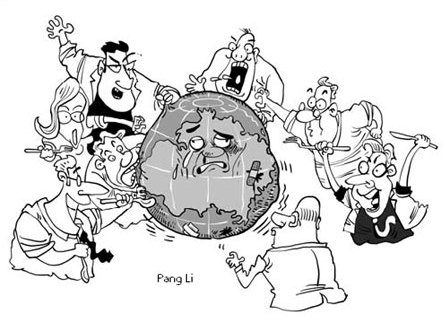
|
OPINION> Commentary
 |
|
Saving earth's resources is to save growth
By Jeffrey D. Sachs (China Daily)
Updated: 2008-07-10 07:34 Reconciling global economic growth, especially in developing countries, with the intensifying constraints on global supplies of energy, food, land, and water is the great question of our time. Commodity prices are soaring worldwide, not only for headline items like food and energy, but for metals, arable land, fresh water, and other crucial inputs to growth, because increased demand is pushing up against limited global supplies. Worldwide economic growth is already slowing under the pressures of $140-per-barrel oil and grain prices that have more than doubled in the past year. A new global growth strategy is needed to maintain global economic progress. The basic issue is that the world economy is now so large that it is hitting against limits never before experienced. There are 6.7 billion people, and the population continues to rise by around 75 million per year, notably in the world's poorest countries. Annual output per person, adjusted for price levels in different parts of the world, averages around $10,000, implying a total output of around $67 trillion. There is, of course, an enormous gap between rich countries, at roughly $40,000 per person, and the poorest, at $1,000 per person or less. But many poor countries, most famously China and India, have achieved extraordinary economic growth in recent years by harnessing cutting-edge technologies. As a result, the world economy has been growing at around 5 percent per year in recent years. At that rate, the world economy would double in size in 14 years.  This is possible, however, only if the key growth inputs remain in ample supply, and if human-made climate change is counteracted. If the supply of vital inputs is constrained or the climate destabilized, prices will rise sharply, industrial production and consumer spending will fall, and world economic growth will slow, perhaps sharply. Many free-market ideologues ridicule the idea that natural resource constraints will now cause a significant slowdown in global growth. They say that fears of "running out of resources," notably food and energy, have been with us for 200 years, and we never succumbed. Indeed, output has continued to rise much faster than population. This view has some truth. Better technologies have allowed the world economy to continue to grow despite tough resource constraints in the past. But simplistic free-market optimism is misplaced for at least four reasons. First, history has already shown how resource constraints can hinder global economic growth. After the upward jump in energy prices in 1973, annual global growth fell from roughly 5 percent between 1960 and 1973 to around 3 percent between 1973 and 1989. Second, the world economy is vastly larger than in the past, so that demand for key commodities and energy inputs is also vastly larger. Third, we have already used up many of the low-cost options that were once available. Low-cost oil is rapidly being depleted. The same is true for ground water. Land is also increasingly scarce. Finally, our past technological triumphs did not actually conserve natural resources, but instead enabled humanity to mine and use these resources at a lower overall cost, thereby hastening their depletion. Looking ahead, the world economy will need to introduce alternative technologies that conserve energy, water, and land, or that enable us to use new forms of renewable energy (such as solar and wind power) at much lower cost than today. Many such technologies exist, and even better technologies can be developed. One key problem is that the alternative technologies are often more expensive than the resource-depleting technologies now in use. For example, farmers around the world could reduce their water use dramatically by switching from conventional irrigation to drip irrigation, which uses a series of tubes to deliver water directly to each plant while preserving or raising crop yields. Yet the investment in drip irrigation is generally more expensive than less-efficient irrigation methods. Poor farmers may lack the capital to invest in it, or may lack the incentive to do so if water is taken directly from publicly available sources or if the government is subsidizing its use. Similar examples abound. With greater investments, it will be possible to raise farm yields, lower energy use to heat and cool buildings, achieve greater fuel efficiency for cars, and more. With new investments in research and development, still further improvements in technologies can be achieved. Yet investments in new resource-saving technologies are not being made at a sufficient scale, because market signals don't give the right incentives, and because governments are not yet cooperating adequately to develop and spread their use. If we continue on our current course - leaving fate to the markets, and leaving governments to compete with each other over scarce oil and food - global growth will slow under the pressures of resource constraints. But if the world cooperates on the research, development, demonstration, and diffusion of resource-saving technologies and renewable energy sources, we will be able to continue to achieve rapid economic progress. A good place to start would be the climate-change negotiations now underway. The rich world should commit to financing a massive program of technology development - renewable energy, fuel-efficient cars, and green buildings - and to a program of technology transfer to developing countries. Such a commitment would also give crucial confidence to poor countries that climate-change control will not become a barrier to long-term economic development. The author is a professor of economics and director of the Earth Institute at Columbia University The Korea Herald (China Daily 07/10/2008 page9) |